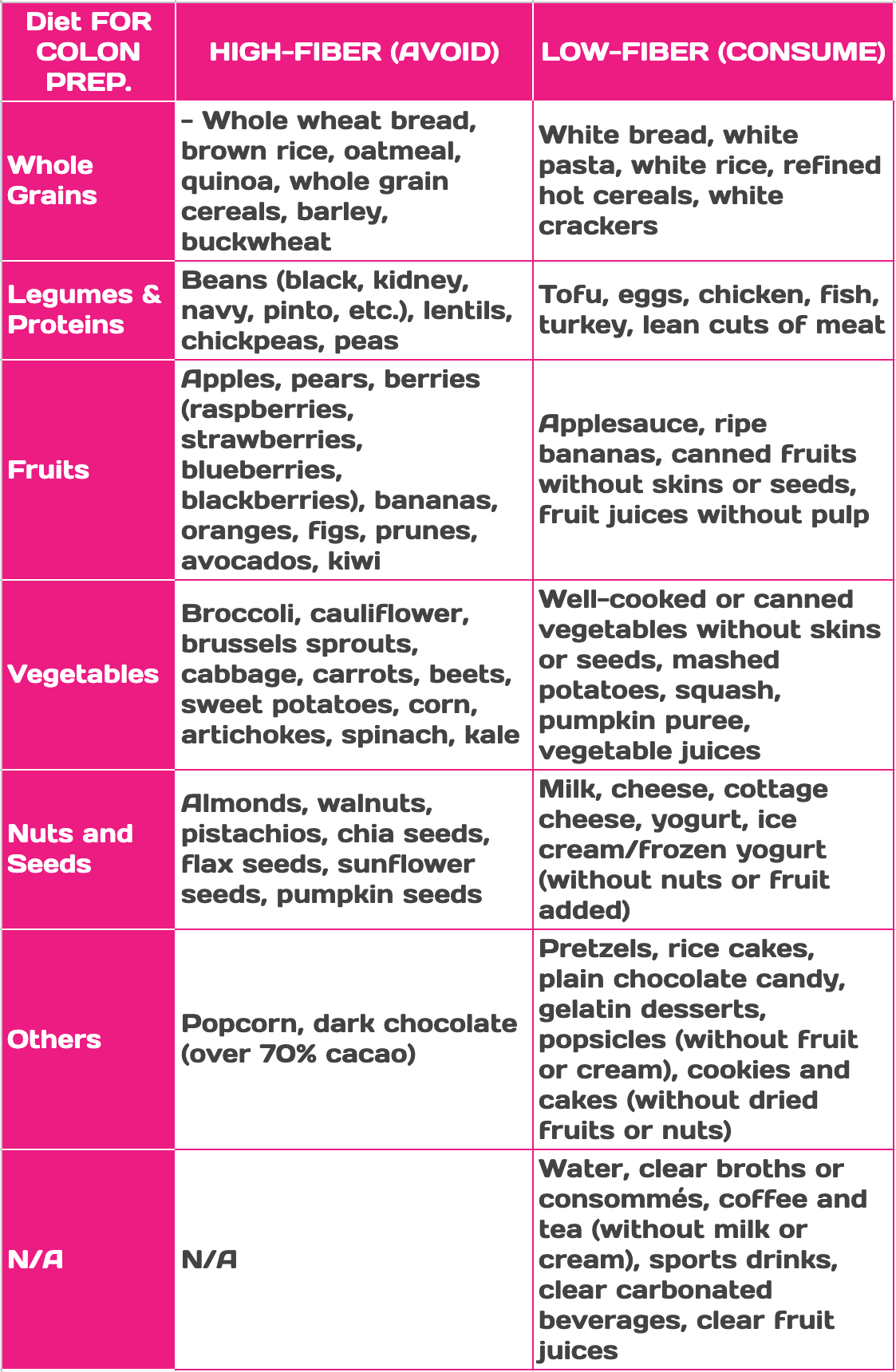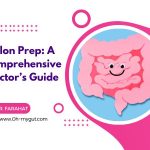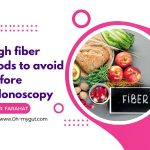Colon Prep: A comprehensive Doctor’s Guide (with Free Checklist).
Our content is not intended nor recommended as a substitute for medical advice by your doctor. Use for informational purposes only.
Hello there, I’m Dr. Farahat, and I welcome you to this comprehensive guide on colonoscopy preparation.
Have you ever thought of a colonoscopy as a journey? A journey that, with the right preparation, can lead you towards the destination of optimal health and peace of mind?
Well, strap in because we’re about to embark on this vital voyage together.
By the end of this article, you will be fully equipped with everything you need to know about prepping for a colonoscopy. From dietary tweaks to medication adjustments to the big day itself and beyond, consider this your go-to guide.
So, let’s demystify the process and empower you to navigate your colonoscopy prep like a pro.
[1] Two weeks before colonoscopy.
Schedule the Procedure
- Reach out to your healthcare provider to schedule your colonoscopy.
- Schedule your appointment when you have a few days off from work or other commitments for stress-free preparation and recovery.
Discuss Medications with Your Doctor
- Inform your doctor about all medications you are taking, including prescription drugs, over-the-counter medicines, vitamins, and herbal supplements.
- If you are on blood thinners like warfarin, clopidogrel, or daily aspirin, these medications may need to be adjusted before the procedure to minimize bleeding risks.
- Diabetes medications may also need adjustments due to the required fasting before the procedure.
- Always consult your doctor before making any changes to your medication regime.
Arrange Transportation
- As you’ll be sedated during the procedure, arrange reliable transportation for the day of your colonoscopy.
- Ensure you have someone who can accompany you to the appointment and drive you home afterward.
[2] One week before colonoscopy.
- Stop/adjust medications or supplements that interfere with your colonoscopy.
- Avoid high
The week leading up to your colonoscopy is important. In order to get the most accurate results from your colonoscopy, there are a few key steps you need to take one week out.
Stop/adjust Medications or Supplements that Interfere with Colonoscopy.
During the week leading up to your colonoscopy, certain medications and supplements may need to be stopped. This is because some substances can interfere with the procedure by increasing the risk of bleeding, impacting visibility, or causing other complications.
- Blood-thinning medications are the most common examples of these. They may need to be paused or adjusted under the guidance of your doctor to reduce the risk of bleeding during the colonoscopy. Examples include aspirin, warfarin, clopidogrel, and some types of non-steroidal anti-inflammatory drugs.
- Certain dietary supplements, such as iron, may also need to be stopped a week before your colonoscopy. Iron can darken the inside of your colon, making it harder for the doctor to view your colon properly.
The table below summarizes the most common medications to avoid or adjust during a colonoscopy preparation (Work with your doctor to ensure safety and to avoid potential complications of stopping or modifying the dose of medications.
| Medication Category | Examples | Notes |
|---|---|---|
| Blood Thinners | Warfarin (Coumadin), Clopidogrel (Plavix), Aspirin, Ibuprofen, Naproxen | These drugs can increase the risk of bleeding during the colonoscopy. Do not stop or adjust these medications without consulting your doctor. |
| Iron Supplements | Ferrous sulfate, Ferrous gluconate, Ferrous fumarate | Iron can darken the inside of the colon, which can interfere with visibility during the colonoscopy. |
| Diabetes Medication | Insulin, Metformin, Glipizide | Adjustments may need to be made due to the fasting required before a colonoscopy. Consult with your doctor. |
| Certain Herbal Supplements | Ginkgo Biloba, Garlic, Ginseng, Ginger, Echinacea, St. John’s Wort, Valerian | Some herbal supplements may increase bleeding risk or interact with sedation medications. |
| Other Antiplatelets | Ticlopidine, Prasugrel, Ticagrelor | These can increase the risk of bleeding. Consult with your doctor before making any changes. |
Remember, you should never stop taking your prescribed medications without discussing them with your doctor. Consult your healthcare provider for guidance on how to manage your medications and supplements in the week before your colonoscopy.
Avoid High-Fiber Foods
A low-fiber diet a week before your colonoscopy can help clear out your colon and make the bowel prep phase easier. High-fiber foods can leave residue in the colon that might obscure the view during the colonoscopy.
You should avoid whole grains, seeds, nuts, raw fruits and vegetables, and dried fruits. Instead, focus on consuming easily digestible foods like white bread, rice, pasta, cooked vegetables without skin, lean meat, eggs, and dairy products. Remember to hydrate well by drinking plenty of water and clear liquids.

Read the Preparation Instruction Your Doctor Provided Thoroughly
Lastly, it’s vital to carefully read and understand the bowel prep instructions your doctor has provided. Each doctor or clinic might have a slightly different procedure, so it’s crucial to follow the specific instructions given to you.
These instructions will guide you on what you can eat or drink, which medications you can take, and when to start the bowel cleansing process.
Understanding and adhering to these instructions is critical to ensuring a successful colonoscopy. If your colon is not properly prepared and cleaned, your doctor may not be able to see polyps or other abnormalities clearly, which might lead to the need for a repeat procedure.
[3] Three to four days before the colonoscopy.
Start a Low-Fiber Diet
One of the most important steps in preparing for a colonoscopy is modifying your diet. Starting 3-4 days before the procedure, you should follow a low-fiber diet. This diet helps to clear out the intestines and reduce the amount of stool in the colon, which allows your doctor to see the colon walls during the procedure clearly.
Here’s what a low-fiber diet might look like:
- Bread and Grains: Opt for white bread and rice instead of their whole-grain counterparts. These are easier to digest and less likely to leave residue in the colon.
- Protein: Lean meats such as chicken, turkey, or fish are excellent choices. You can also include eggs in your diet.
- Vegetables: While you should generally avoid raw vegetables, you can consume well-cooked vegetables. However, remove any skins or seeds before eating, as these are high in fiber.
Remember, the goal is to consume foods that are easy to digest and won’t leave much residue in your colon. Avoid high-fiber foods such as whole grains, nuts, seeds, raw vegetables, and fruits with skins or seeds.
Get your colonoscopy prep ready.
In addition to modifying your diet, you’ll also need to prepare your colonoscopy solution. This is a special drink that helps clean out your colon before the procedure. Your doctor will typically prescribe this solution and provide specific instructions on when and how to take it.
Ensure you have your colonoscopy preparation solution ready 3-4 days before your procedure. If you haven’t received it yet, contact your doctor or pharmacy. Read the instructions carefully and ask your doctor if you have any questions.
[4] Two days before the colonoscopy.
Nothing specific; continue to avoid the high-fiber diet and eat low-fiber alternatives instead.
[5] One day before colonoscopy
The day before your colonoscopy is crucial in ensuring a successful procedure. This is when you’ll switch to a clear liquid diet and take the first dose of your colonoscopy prep solution. Here’s a detailed guide on what you should do one day before your colonoscopy.
1. Switch to a Clear Liquid Diet
On the day before your colonoscopy, you’ll need to switch from a low-fiber diet to a clear liquid diet. This diet helps to ensure that your colon is as clean as possible for the procedure.
Here’s what you can consume on a clear liquid diet:
- Broths: Clear broths such as chicken, beef, or vegetable are acceptable. Make sure they don’t contain any solid pieces like vegetables or noodles.
- Clear Juices: You can drink clear juices such as apple or white grape juice. Avoid any juices that contain pulp.
- Tea and Coffee: You can have tea or coffee, but make sure not to add any milk or creamer. Sugar or honey is acceptable.
- Gelatin and Popsicles: You can have gelatin or popsicles, but avoid any that are red or purple. These colors can stain the colon and make it harder for your doctor to see during the procedure.
Remember, the goal is to consume liquids that leave no residue in your colon. Avoid any liquids that are not clear or that contain pulp or dairy.
2. Take the First Dose of Your Colonoscopy Prep Solution
In addition to your clear liquid diet, you’ll also need to take the first dose of your colonoscopy prep solution. This solution helps to clean out your colon so that your doctor can clearly see the colon walls during the procedure.
Your doctor will provide specific instructions on when and how to take your colonoscopy prep solution. Typically, you’ll take the first dose in the evening, the day before your procedure. Make sure to follow your doctor’s instructions carefully.
Taking your colonoscopy prep solution may cause diarrhea, so be sure to stay near a bathroom after you take it. It’s also important to stay hydrated by drinking plenty of clear liquids.
Remember, the preparation for a colonoscopy is just as important as the procedure itself. By following a clear liquid diet and taking your colonoscopy prep solution as directed, you’re helping to ensure that your doctor can get the best possible view of your colon, leading to more accurate results.
Here’s a table that outlines some of the most commonly used colonoscopy prep solutions in the United States, along with their methods of administration.
| Colon Prep Solution | Method of Administration |
|---|---|
| GoLYTELY | Mixed with water to a total volume of 4 liters (about a gallon). The patient drinks the solution in divided doses: typically 3-4 liters the night before the procedure and the remaining liter a few hours before the procedure. |
| Suprep | Two 6-ounce bottles are provided. Each bottle is mixed with water to make a 16-ounce solution. The first bottle is taken the night before the procedure, and the second bottle is taken about four hours prior to the colonoscopy. |
| MoviPrep | Comes in two 1-liter pouches. Each pouch is mixed with water and consumed in the evening before and the morning of the procedure. |
| Prepopik | Two packets are provided. Each packet is mixed with 5 ounces of cold water and consumed. The first packet is taken the evening before the procedure, and the second is taken the following morning, a few hours prior to the colonoscopy. |
| Miralax | Miralax powder is mixed with 64 ounces of a clear liquid, often Gatorade. The solution is consumed the evening before the procedure. |
| CLENPIQ | Two 5.4-ounce bottles are provided. The first bottle is taken in the evening before the procedure, and the second bottle is taken the next morning, several hours prior to the colonoscopy. |
[6] the day of the colonoscopy
The day of your colonoscopy has finally arrived. After all the preparations, it’s time to focus on the final steps. Knowing exactly what to do on this important day can help minimize stress and ensure everything goes as smoothly as possible. Here’s a step-by-step guide to what you should do on the day of your colonoscopy.
1. The Early Morning Routine
Begin your day by taking the second half of your colonoscopy prep solution. This should be done approximately 4-6 hours before your scheduled appointment. Completing your prep solution is crucial for the colonoscopy’s success, as it ensures your colon is thoroughly cleaned and allows the doctor to have the clearest possible view.
2. Maintaining Hydration and Fasting
After taking your prep solution, continue to hydrate by drinking clear liquids. This will help keep your body hydrated, which is especially important because the prep solution can cause you to lose a significant amount of fluid. Acceptable clear liquids include water, clear broths, apple juice, white grape juice, and sports drinks. However, stop all intake at least 2 hours before the procedure to ensure your stomach is empty, as this will provide the safest conditions for sedation during the colonoscopy.
3. Packing Essentials
When preparing to leave for your appointment, pack the necessary items. This includes your identification, insurance card, a list of your current medications, any known allergies, and a copy of any advanced directives. These items will ensure your healthcare team has all the information they need to provide the best care possible.
4. Dressing Appropriately
Choose loose, comfortable clothing for the day of your colonoscopy. You will need to change into a hospital gown for the procedure, and wearing easy-to-remove clothing can make this process easier. Comfortable clothes will also make your recovery period more relaxing.
5. Leaving Valuables at Home
It’s best to leave jewelry and other valuables at home. Not only can they potentially interfere with the procedure, but there’s also the risk of misplacement or loss in the hospital or clinic setting. To ensure the safety of your personal items, leave them at home.
6. Arriving on Time
Plan your travel so that you arrive on time for your appointment. Arriving on time allows for a smoother process and ensures the medical team has sufficient time to prepare you for the procedure. It’s advisable to consider possible traffic or public transport delays when planning your journey.
[7] After the colonoscopy.
Once your colonoscopy is successfully completed, the focus shifts to recovery and post-procedure care. It’s important to follow certain guidelines to ensure a smooth recovery. Let’s walk through some key steps you should take after your colonoscopy.
1. Organize a Safe Journey Home
First and foremost, make sure you have arranged for someone to drive you home. This is not just a suggestion but a necessity. Since you will have been sedated for the procedure, your reaction times and judgment may be impaired, making it unsafe for you to drive. If you haven’t arranged transportation, many medical centers will not proceed with the colonoscopy.
2. Take Time to Rest and Relax
Once you’re safely home, it’s crucial to rest and relax for the rest of the day. Even though a colonoscopy is a relatively routine procedure, your body has undergone a significant process. The sedatives used during the procedure can make you feel drowsy, and it may take several hours for their effects to completely wear off. Use this time to rest, hydrate, and allow your body to recover.
3. Gradually Resume Eating
After your colonoscopy, you can start eating again. However, it’s wise to reintroduce food to your system gradually. Begin with light meals such as broth and soups. If these are well tolerated, you can slowly add more substantial foods to your diet. If your doctor has given you specific dietary instructions, be sure to follow those.
4. Resume Regular Medications
After a colonoscopy, you can typically resume your regular medications. However, there may be certain exceptions depending on what was found during the colonoscopy, the specific procedures carried out, or your overall health. Therefore, it’s crucial to follow your doctor’s instructions. If you’re unsure, don’t hesitate to reach out to your healthcare provider for clarification.
- Evidence-based
- Written by a doctor.






